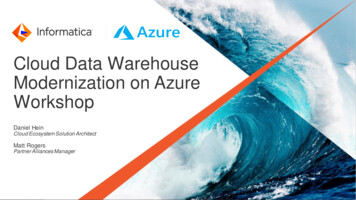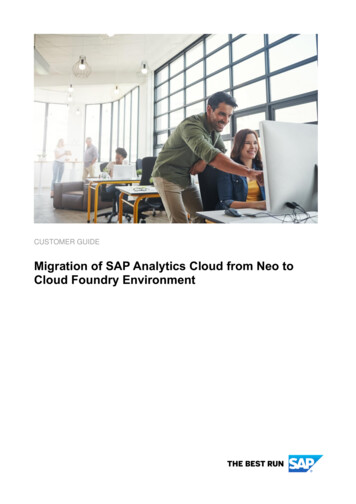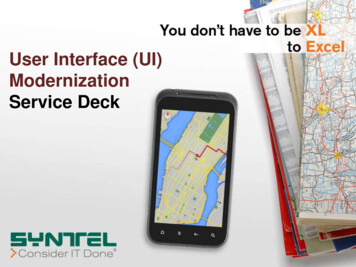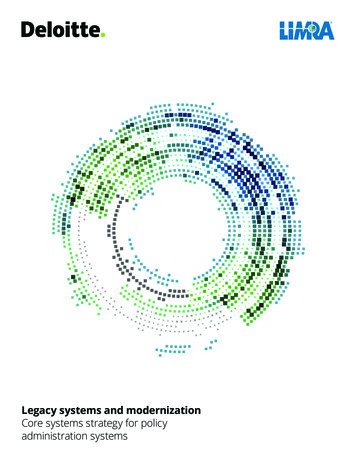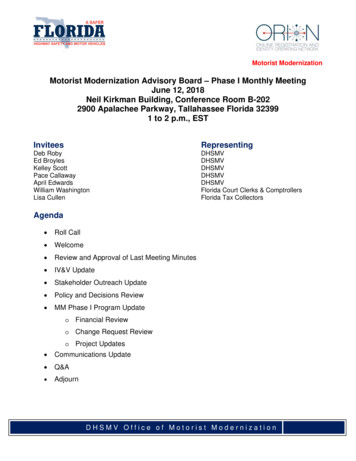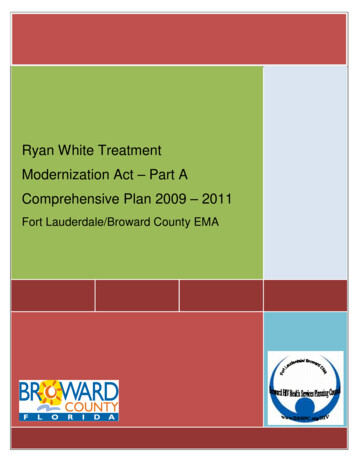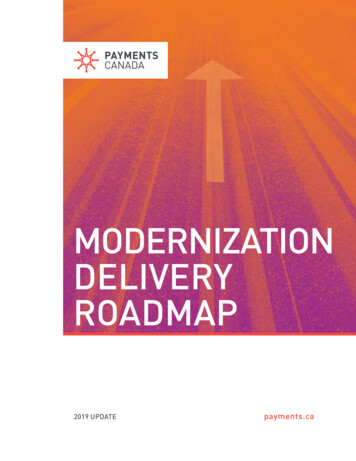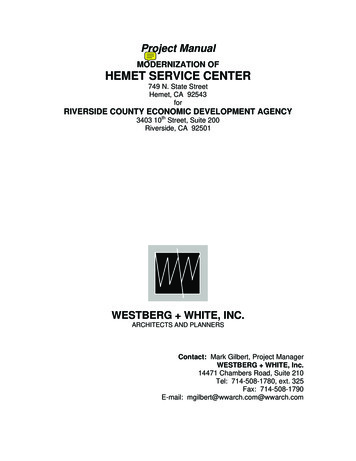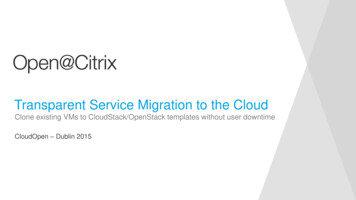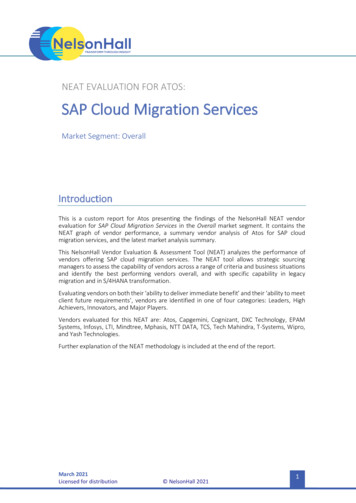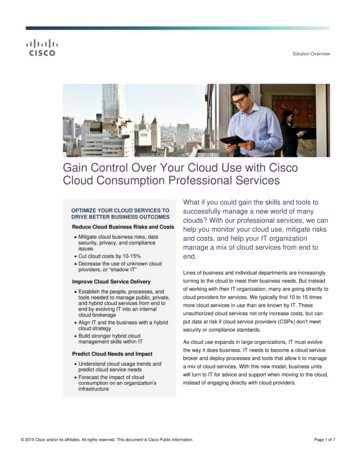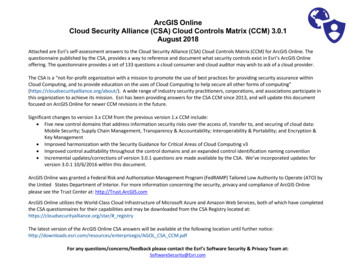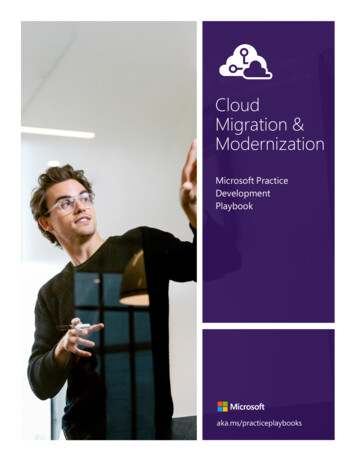
Transcription
ARTIFICIAL INTELLIGENCEPAGE 1CloudMigration &ModernizationMicrosoft saka.ms/practiceplaybooks
About this PlaybookThis playbook is intended for the business and technical leadership for new and existing Microsoftpartners focused on migrating workloads to Microsoft Azure or modernizing legacy applicationsto the cloud.ObjectivesHow this playbook was madeThe goal of this playbook is to help partners accelerateand optimize their Azure-focused practice by teachingthem the ins-and-outs of migrating workloads ormodernizing applications and hosting them in MicrosoftAzure.This playbook is part of a series of guidance written byMicrosoft Partner Opsgility, in conjunction with theMicrosoft One Commercial Partner group and 12 othersuccessful Azure partners that have volunteered their timeto provide input and best practices to share with the restof the partner community.For the business side, this playbook provides anunderstanding of the strategies for building a migrationor modernization practice, including which workloads tofocus on, how to price the services, and how to build thetechnical team.For the technical side, this playbook provides detailedguidance on how to plan and execute the migration of anexisting workload or application to Azure, includingadvice on different approaches, useful tools, and technicaldetails on best practices with infrastructure migrations.Application modernization, optimization, andmanagement are discussed, as are Azure best practicesand advice on how to build unique IP to make a migrationpractice more successful.To validate the guidance provided in these playbooks, weworked with MDC Research to conduct a survey of 364global partners who are currently selling Azure migrationservices to customers and offering or actively workingtowards offering cloud services. In this survey, wegathered insights on a range of topics, including howpartners hire, compensate and train resources; theirbusiness model, revenue and profitability; what practicesand services they offer; and what skillsets they have inplace to support their offers. The results of this survey areprovided in line with the guidance found within thisplaybook.CON T RI B UT IN G P ART N ERSAttunixHanuBitTitanSentiaCAPSiDEInframonClear PeopleInterceptCloud DirectRackspaceDaisy GroupTCSaka.ms/practiceplaybooks
ABOUT THIS PLAYBOOKPAGE 3Using the playbookQuickly read through the playbook to familiarize yourself with the layout and content. Eachsection includes an executive summary and key actions for that specific topic. Review thesesummaries first to decide which areas to focus on. Go over the content several times, ifneeded, then share with your team.TO GET THE MOST VALUE OUT OF THIS PLAYBOOK: Get the team together and discuss which pieces of the strategy each person is responsible for. Share the playbook with sales, marketing, support, technical, and managed services teams. Leverage the resources available from Microsoft to help maximize profitability. Share feedback on how we can improve this and other playbooks by ticeplaybooks
ABOUT THIS PLAYBOOK““Every company is a software company. Youhave to start thinking and operating like adigital company. It’s no longer just aboutprocuring one solution and deploying one.It’s not about one simple software solution.It’s really you yourself thinking of your ownfuture as a digital company.”SATYA NADELLACEOMicrosoftaka.ms/practiceplaybooksPAGE 4
ABOUT THIS PLAYBOOKPAGE 5Table of ContentsAbout this Playbook . 2Customized Virtual Machine Images . 82Digital Transformation . 6Migrating to Virtual Machines . 83The Cloud Migration Opportunity . 10Migrating Disks . 84Define Your Strategy .11Migrating using Azure Site Recovery . 85The Big Picture of Migration . 13Migrating VMware Workloads. 86Identify Target Customers . 14Migration Tools . 87Define the Service Offering . 16Business Continuity . 89Defining the Pricing Strategy . 20Migrating Existing VMs to CSP . 90Apply for Azure Incentive Programs . 22Migrating Databases. 91Build the Migration Practice . 24Modernizing Apps. 93Landing a Migration Project . 25Modernizing Applications with Azure . 95Executing the First Migration Project. 28Cloud-Native Architecture and Design . 97Leverage Reusable IP . 29Cloud Design Considerations . 99Managed Applications . 31Cloud Design Patterns . 101Managing a Migration Program using a Migration Factory . 32Azure DevTest Labs . 102Guide: Optimize and Grow . 33Migrating Applications to Azure App Service . 105Hire & Train .34Microservices and Containers . 107Building a Migration Team . 36What is Docker? . 108Job Descriptions for the Migration Team . 37Modern Data Platform . 109Reskilling Existing Technical Resources .44Cognitive Services and AI . 111Hiring and Onboarding. 47Optimize & Manage . 112Training & Readiness . 48Cost Optimization.114Competencies and Certifications . 52Azure Cost Management. 115Migration Assessment .55Automatic Shutdown of VMs . 126Discovery . 57Optimized Architecture . 128Planning. 61Azure Management Best Practices . 134Evaluation . 67Azure Subscriptions. 135Lift & Shift.69Resource Organization . 138Building Out the Network .71Controlling access to Azure Resources . 139Network Appliances . 75Security and Compliance . 140The Virtual Data Center. 76Infrastructure as Code .141Enabling Hybrid Identity. 77Azure Resource Manager Templates . 142Planning for Storage . 78Blueprints . 143File Shares . 79Automated Scripts . 144Choosing Virtual Machines . 80Azure SDKs and REST APIs. 145Availability Options . 81Playbook Summary . 146June 2020aka.ms/practiceplaybooks
ABOUT THIS PLAYBOOKPAGE 6Digital TransformationThe path to unprecedented growth goes through the cloud, helping customers connectpeople, data, and processes in new ways to embrace the possibilities enabled by moderntechnologies. To succeed in a digital-first world, business leaders are bringing business and ITcloser together and optimizing processes to create new value for customers.The potential is huge. By 2019, IDC predicts 1.7 trillion USD in spending worldwide to create new business models,operational efficiencies, and customer experiences. Digital transformation is now an executive mandate and partnerdevelopment capabilities will take advantage of customer demand for custom and packaged software.Three trends are helping shape this profitability opportunity:DIGITAL PLATFORMS AND ECOSYSTEMSBy 2020, 60% of all enterprises will have fully articulated an organization-wide digital platformstrategy and will be in the process of implementing that strategy as the new IT core for competing inthe digital economy.CLOUDBy 2021, spending on cloud services and cloud-enabling hardware, software and services will morethan double to over 530 billion, leveraging the diversifying cloud environment that is 20% at theedge, and over 90% multi-cloud.HYPER-AGILE APPLICATIONSBy 2021, enterprise apps will shift toward hyper-agile architectures, with 80% of applicationdevelopment on cloud platforms (PaaS) using microservices and cloud functions, and over 95% ofnew microservices deployed in containers.Partners play a key role in helping businesses make the platform and cultural shifts needed, and such transformations arecreating amazing partner multiples. In a recent IDC study, partners reported earning 9.64 in revenue for every 1 ofMicrosoft revenue generated in 2017. This is expected to continue through 2022 and include a mix of software (45%), services(50%), and hardware (5%), that are sold in relation to Microsoft solutions.aka.ms/practiceplaybooks
ABOUT THIS PLAYBOOKPAGE 7These changes affect all aspects of a modern business, both internal and external. Microsoftmodels these changes in four ZINGOPERATIONSGive them new personalizedexperiences that bolsteracquisition and strengthenloyalty.Boost productivity withDrive efficiencies with aflexible workstyles andcloud platform thatmobile solutions that enable accelerates agility.a data-driven culture.TRANSFORMINGPRODUCTSCreate new revenueopportunities usingintelligent technology toinnovate new products andprocesses.Customer centricityintegrated acrossthe businessIntentional aboutpeople priorit
guidance on how to plan and execute the migration of an existing workload or application to Azure, including advice on different approaches, useful tools, and technical details on best practices with infrastructure migrations. Application modernization, optimization, and management are discussed, as are Azure best practices and advice on how to build unique IP to make a migration practice more .
